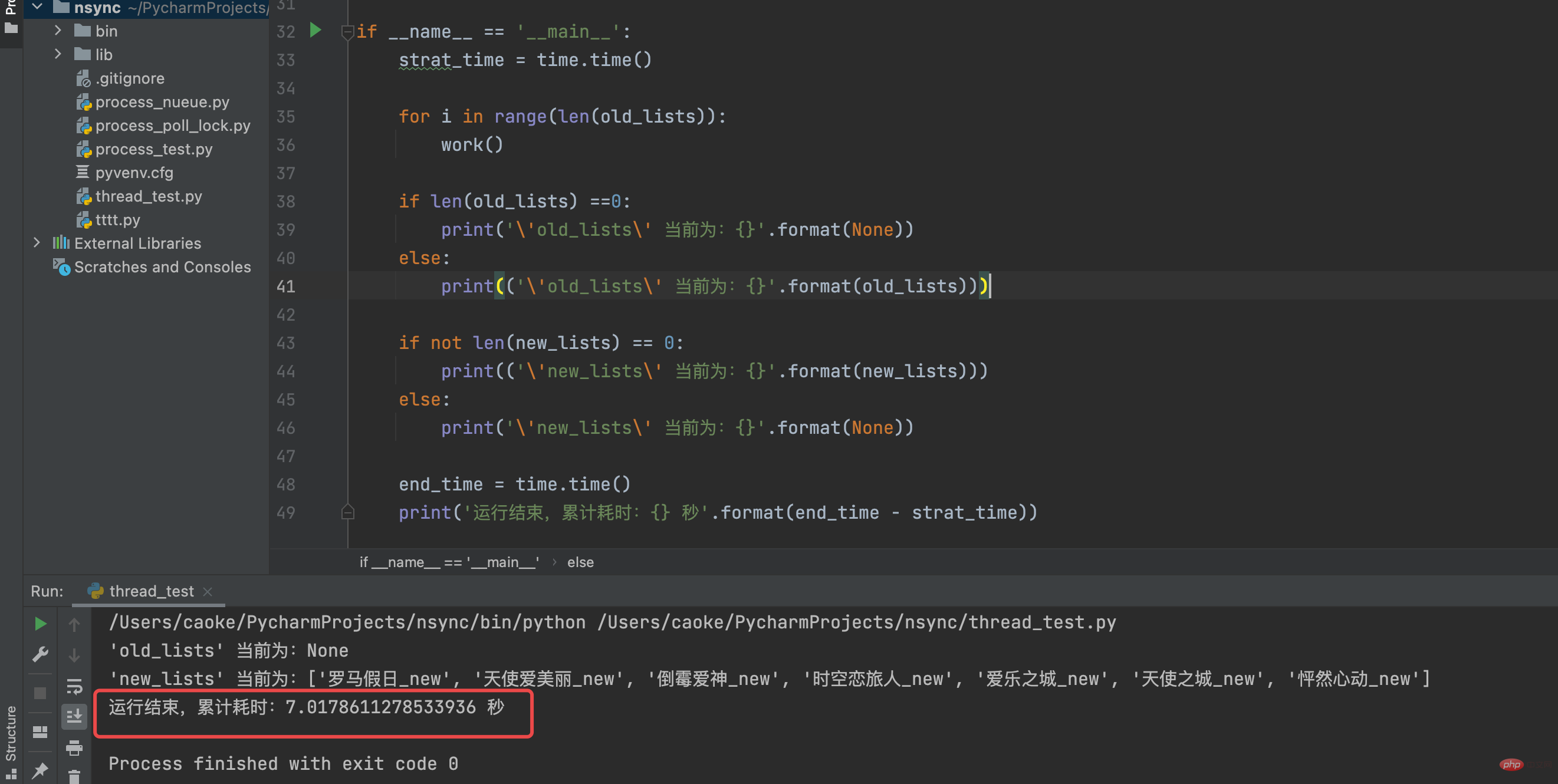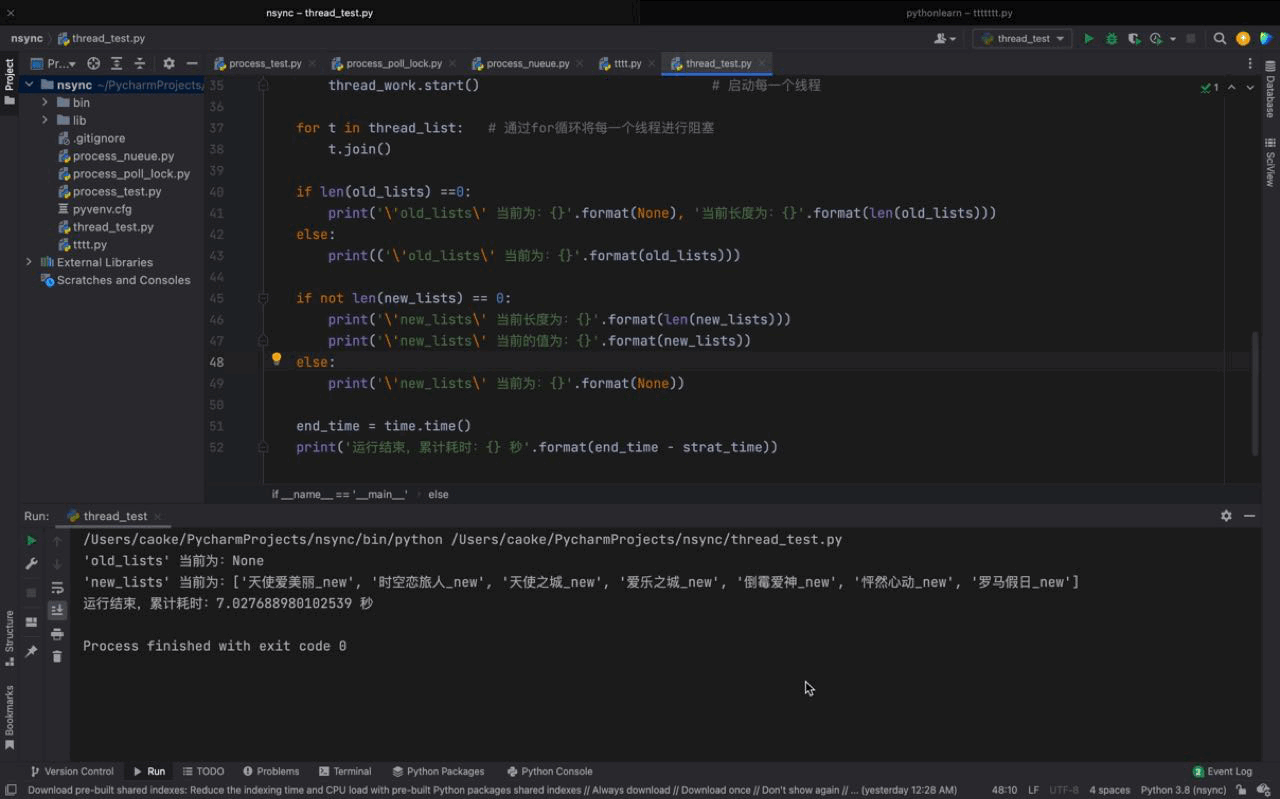 Backend Development
Backend Development
 Python Tutorial
Python Tutorial
 Creation and common methods of Python threads (detailed examples)
Creation and common methods of Python threads (detailed examples)
Creation and common methods of Python threads (detailed examples)
This article brings you relevant knowledge about python. It mainly introduces the creation and common methods of threads, as well as some thread demonstration cases. Let’s take a look at them together. I hope Helpful to everyone.

Recommended learning: python video tutorial
Creation and use of threads
There are many multi-threading modules in Python, among which the threading module is more commonly used. Let's take a look at how to use threading to create threads and its common methods.
Thread creation-threading
Common methods of thread objectsThread
##Function name Introduction Example Thread # Introduction to the kinetic energy of ##Thread: Instantiate a thread object by calling theCreate thread Thread(target, args) class of the
threadingmodule; it has two parameters:target and args(Same parameters as when creating a process).targetis the function to be executed when creating a thread, andargsis the parameters that need to be passed in when executing this function.
Let’s take a look at the common methods of thread objects:
Function name
##start Introduction Usage Start the thread start() join Block the thread until the thread execution ends join(timeout=None) getName Get the name of the thread getName() setName Set The name of the thread setName(name) is_alive Determine whether the thread is alive is_alive() setDaemon Daemon thread setDaemon(True)
- start function: Start a thread; does not have any return value or parameters.
- join function: the same as the join function in the process; blocking the current program, the main thread's task needs to wait for the current sub-thread's task to end before it can continue to execute; the parameter is
timeout: Represents the blocking timeout.- getName function: Get the name of the current thread.
- setName function: set the name for the current thread; the parameter is
name: it is a string type- is_alive function: determine whether the status of the current thread is in stock
- setDaemon function: It is a daemon thread; if the script task is completed, it will be forcibly terminated even if the process pool has not completed its business. The same is true for child threads. If you want the main process or the main thread to finish its own business first, and still allow the child threads to continue working instead of forcibly closing them, you only need to set
setDaemon()toTrueThat’s it.PS: Through the above introduction, you will find that the functions in the thread object are almost very similar to the functions in the process object. Their usage methods and usage scenarios are almost the same.
Thread demonstration case
Single-thread initial case
Demonstration
Before multi-threadingLet’s take a look at the following case first, and then see how long it took in total after running it1. Define a list and write some content in it.
2. Define a new list, randomly write the contents of the previous list into the new list; and delete the randomly obtained contents from the previous list.
3. You need to use
r andombuilt-in moduleThe code example is as follows:
# coding:utf-8import timeimport random old_lists = ['罗马假日', '怦然心动', '时空恋旅人', '天使爱美丽', '天使之城', '倒霉爱神', '爱乐之城']new_lists = []def work(): if len(old_lists) == 0: # 判断 old_list 的长度,如果为0 ,则表示 该列表的内容已经被删光了 return '\'old_list\' 列表内容已经全部删除' old_choice_data = random.choice(old_lists) # random 模块的 choice函数可以随机获取传入的 old_list 的元素 old_lists.remove(old_choice_data) # 当获取到这个随机元素之后,将该元素从 old_lists 中删除 new_choice_data = '%s_new' % old_choice_data # 将随机获取到的随机元素通过格式化方式重新赋值,区别于之前的元素 new_lists.append(new_choice_data) # 将格式化的新的随机元素添加至 new_lists 列表 time.sleep(1)if __name__ == '__main__': strat_time = time.time() for i in range(len(old_lists)): work() if len(old_lists) ==0: print('\'old_lists\' 当前为:{}'.format(None)) else: print(('\'old_lists\' 当前为:{}'.format(old_lists))) if not len(new_lists) == 0: print(('\'new_lists\' 当前为:{}'.format(new_lists))) else: print('\'new_lists\' 当前为:{}'.format(None)) end_time = time.time() print('运行结束,累计耗时:{} 秒'.format(end_time - strat_time))Copy after loginThe running result is as follows:
From the running output results, we can see that the entire script takes 7 seconds to run, and
new_listsThe elements in the list have been formatted and added_new; Not only that, because of therandom module's choice function, the content order ofnew_listsis also different fromold_lists; each The running order will be different every time, so the order ofold_listscannot be guaranteed.
Multi-threaded demonstration case
The code example is as follows:
# coding:utf-8import timeimport randomimport threading old_lists = ['罗马假日', '怦然心动', '时空恋旅人', '天使爱美丽', '天使之城', '倒霉爱神', '爱乐之城']new_lists = []def work(): if len(old_lists) == 0: # 判断 old_list 的长度,如果为0 ,则表示 该列表的内容已经被删光了 return '\'old_list\' 列表内容已经全部删除' old_choice_data = random.choice(old_lists) # random 模块的 choice函数可以随机获取传入的 old_list 的元素 old_lists.remove(old_choice_data) # 当获取到这个随机元素之后,将该元素从 old_lists 中删除 new_choice_data = '%s_new' % old_choice_data # 将随机获取到的随机元素通过格式化方式重新赋值,区别于之前的元素 new_lists.append(new_choice_data) # 将格式化的新的随机元素添加至 new_lists 列表 time.sleep(1)if __name__ == '__main__': strat_time = time.time() print('\'old_lists\'初始长度为:{}'.format(len(old_lists))) # 获取 old_lists 与 new_lists 最初始的长度 print('\'new_lists\'初始长度为:{}'.format(len(new_lists))) thread_list = [] # 定义一个空的 thread_list 对象,用以下方添加每个线程 for i in range(len(old_lists)): thread_work = threading.Thread(target=work) # 定义一个线程实例化对象执行 work 函数,因为 work 函数没有参数所以不用传 args thread_list.append(thread_work) # 将 thread_work 添加进 thread_list thread_work.start() # 启动每一个线程 for t in thread_list: # 通过for循环将每一个线程进行阻塞 t.join() if len(old_lists) ==0: print('\'old_lists\' 当前为:{}'.format(None), '当前长度为:{}'.format(len(old_lists))) else: print(('\'old_lists\' 当前为:{}'.format(old_lists))) if not len(new_lists) == 0: print('\'new_lists\' 当前长度为:{}'.format(len(new_lists))) print('\'new_lists\' 当前的值为:{}'.format(new_lists)) else: print('\'new_lists\' 当前为:{}'.format(None)) end_time = time.time() print('运行结束,累计耗时:{} 秒'.format(end_time - strat_time))Copy after loginThe running results are as follows:
Judging from the running results, our initial single-threaded task took 7 seconds. After using multi-threading, it only took 1 second to complete, which greatly improved our operating efficiency.
Thread issues
Through the above exercises, we found that the use of threads is almost exactly the same as that of processes. They can all execute programs without interfering with each other, and can also prevent the main thread's program from waiting for the sub-thread's task to be completed before executing it. It’s just that in the demonstration case just now, we used the
join()function to block. You can removejoin()here to see the execution effect.Like processes, threads also have certain problems.
- The function executed by the thread also cannot obtain the return value.
- When multiple threads modify a file at the same time, it will also cause the data of the modified file to be confused (because they all operate a file concurrently, especially when dealing with transaction scenarios, you need to pay special attention).
The problems existing in these threads can also be solved. We will introduce them in detail in the next chapter
Thread Pool and Global Lock.Recommended learning: python video tutorial
The above is the detailed content of Creation and common methods of Python threads (detailed examples). For more information, please follow other related articles on the PHP Chinese website!

Hot AI Tools

Undresser.AI Undress
AI-powered app for creating realistic nude photos

AI Clothes Remover
Online AI tool for removing clothes from photos.

Undress AI Tool
Undress images for free

Clothoff.io
AI clothes remover

AI Hentai Generator
Generate AI Hentai for free.

Hot Article

Hot Tools

Notepad++7.3.1
Easy-to-use and free code editor

SublimeText3 Chinese version
Chinese version, very easy to use

Zend Studio 13.0.1
Powerful PHP integrated development environment

Dreamweaver CS6
Visual web development tools

SublimeText3 Mac version
God-level code editing software (SublimeText3)

Hot Topics
 Is the conversion speed fast when converting XML to PDF on mobile phone?
Apr 02, 2025 pm 10:09 PM
Is the conversion speed fast when converting XML to PDF on mobile phone?
Apr 02, 2025 pm 10:09 PM
The speed of mobile XML to PDF depends on the following factors: the complexity of XML structure. Mobile hardware configuration conversion method (library, algorithm) code quality optimization methods (select efficient libraries, optimize algorithms, cache data, and utilize multi-threading). Overall, there is no absolute answer and it needs to be optimized according to the specific situation.
 Is there any mobile app that can convert XML into PDF?
Apr 02, 2025 pm 08:54 PM
Is there any mobile app that can convert XML into PDF?
Apr 02, 2025 pm 08:54 PM
An application that converts XML directly to PDF cannot be found because they are two fundamentally different formats. XML is used to store data, while PDF is used to display documents. To complete the transformation, you can use programming languages and libraries such as Python and ReportLab to parse XML data and generate PDF documents.
 How to convert XML files to PDF on your phone?
Apr 02, 2025 pm 10:12 PM
How to convert XML files to PDF on your phone?
Apr 02, 2025 pm 10:12 PM
It is impossible to complete XML to PDF conversion directly on your phone with a single application. It is necessary to use cloud services, which can be achieved through two steps: 1. Convert XML to PDF in the cloud, 2. Access or download the converted PDF file on the mobile phone.
 What is the function of C language sum?
Apr 03, 2025 pm 02:21 PM
What is the function of C language sum?
Apr 03, 2025 pm 02:21 PM
There is no built-in sum function in C language, so it needs to be written by yourself. Sum can be achieved by traversing the array and accumulating elements: Loop version: Sum is calculated using for loop and array length. Pointer version: Use pointers to point to array elements, and efficient summing is achieved through self-increment pointers. Dynamically allocate array version: Dynamically allocate arrays and manage memory yourself, ensuring that allocated memory is freed to prevent memory leaks.
 How to control the size of XML converted to images?
Apr 02, 2025 pm 07:24 PM
How to control the size of XML converted to images?
Apr 02, 2025 pm 07:24 PM
To generate images through XML, you need to use graph libraries (such as Pillow and JFreeChart) as bridges to generate images based on metadata (size, color) in XML. The key to controlling the size of the image is to adjust the values of the <width> and <height> tags in XML. However, in practical applications, the complexity of XML structure, the fineness of graph drawing, the speed of image generation and memory consumption, and the selection of image formats all have an impact on the generated image size. Therefore, it is necessary to have a deep understanding of XML structure, proficient in the graphics library, and consider factors such as optimization algorithms and image format selection.
 How to convert xml into pictures
Apr 03, 2025 am 07:39 AM
How to convert xml into pictures
Apr 03, 2025 am 07:39 AM
XML can be converted to images by using an XSLT converter or image library. XSLT Converter: Use an XSLT processor and stylesheet to convert XML to images. Image Library: Use libraries such as PIL or ImageMagick to create images from XML data, such as drawing shapes and text.
 How to open xml format
Apr 02, 2025 pm 09:00 PM
How to open xml format
Apr 02, 2025 pm 09:00 PM
Use most text editors to open XML files; if you need a more intuitive tree display, you can use an XML editor, such as Oxygen XML Editor or XMLSpy; if you process XML data in a program, you need to use a programming language (such as Python) and XML libraries (such as xml.etree.ElementTree) to parse.
 Recommended XML formatting tool
Apr 02, 2025 pm 09:03 PM
Recommended XML formatting tool
Apr 02, 2025 pm 09:03 PM
XML formatting tools can type code according to rules to improve readability and understanding. When selecting a tool, pay attention to customization capabilities, handling of special circumstances, performance and ease of use. Commonly used tool types include online tools, IDE plug-ins, and command-line tools.







